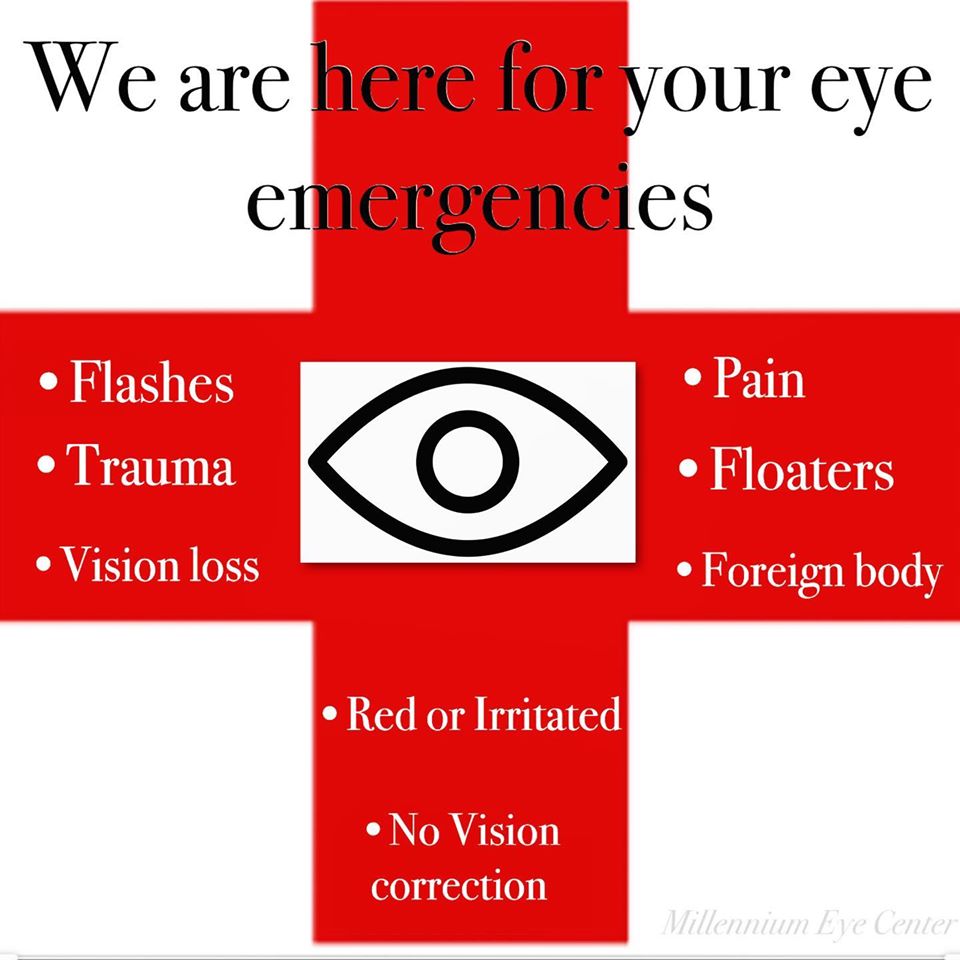Did you know that we treat eye emergencies?
Eye emergencies refer to any sudden onset of symptoms or obvious eye trauma that affect vision. These emergencies range from severe eye pain or vision loss to a sudden blow to the eye or chemical exposure.
If you or any of your family member experience any of the signs below, it’s time to come see one of our eye doctors…
Signs and Symptoms of Eye Emergency
- Feeling pain in the eye
- Vision loss
- Flashes or floaters
- Red or irritated eyes
- No vision correction
- Bleeding of the eye
- Blood in the white of the eye
- Swollen or bulging eye
- Vision loss or double vision
- Pupils that are unequal in size
- Severe photophobia (light sensitivity)
- Being hit in the eye
- Bruising around the eye
- Eye discharge
- Suspected eye infection
- Severe burning, stinging, itching eyes
- Scratched or cut eye or eyelid
- Split contact lenses in the eye
- A piece of broken eyeglass lens in your eye
- Foreign object stuck in the eye
What Should I Do If I Have An Eye Emergency?
The first to take for any eye emergency is to call your eye doctor or go to the nearest hospital near you.
If you have a cut or foreign object in your eye, or if you suffered from other forms of eye trauma, DO NOT:
- Rub your eye
- Attempt to remove any foreign objects embedded in the eye
- Use tweezers or swabs in your eye
- Put any ointments or medication into your eye
First Aid for Eye Injuries
Refer to the following guidelines to prevent any long-term vision loss or eye damage.
Chemical Exposure
If a contact lens is in the eye, do not attempt to remove the contact lens using your fingers. Instead, flush saline solution or water over the lens immediately as it may dislodge the lens. Contact lenses can trap harmful chemicals against the cornea, causing unnecessary damage.
Seek emergency medical care promptly after flushing. Call your eye doctor or go to the nearest hospital near you.
To avoid eye exposure to toxic or abrasive chemicals, always wear protective eyewear and use caution when handling these types of products.
Foreign Objects
Although your first instinct may be to rub your eye to get the foreign object out, try to resist the urge–as rubbing can further damage the eye.
If the object isn’t embedded in the eye, you may try to remove it by flushing it out. First, wash your hands with warm water and soap to prevent contamination or infection. Then, flush the eye thoroughly with clean water or preferably saline, if available. You can also try to induce tearing by using your fingers to gently lift the upper eyelid over the lower eyelid. Causing the eye to tear may flush out the foreign object.
If the object is visible, and not embedded on the eye, you can try to gently wipe it away with a damp, clean washcloth.
Seek immediate medical attention if the above methods do not work. Call your eye doctor or go to the nearest hospital near you.
Blows to the Eye
To treat a black eye, apply a cold compress to decrease swelling and support healing. Use the compress for 5 to 10 minutes at a time, allowing the eye to rest between applications. A cold compress can be made by wrapping a bag of peas, or other soft frozen items, in a clean cloth.
Never place ice directly on the skin; use a clean cloth between the skin and ice; and always follow your eye doctor’s advice.

